Ever thought about what to call a group of baby birds? The world of birds is full of special names for their young. Discovering these terms gives us a peek into the world of bird study. It also helps us learn about the behaviors and traits of baby birds.
Key Takeaways
- Collective nouns for baby birds vary by species, from a “brood” of chicks to a “peep” of young chickens.
- Understanding these specialized terms sheds light on the diverse world of avian offspring and their development.
- Familiarizing oneself with baby bird group names can enhance birdwatching experiences and appreciation for our feathered friends.
- The origins and usage of these collective nouns reflect the deep-rooted traditions in bird terminology.
- Exploring the nuances of baby bird group names offers a deeper understanding of the intricate lives of our avian companions.
Understanding Baby Bird Group Names: A Basic Guide
Collective nouns are key in ornithology and birdwatching. They help us talk about baby birds in a special way. From the tiny hatchling covey to the lively fledgling bevy, each name tells us about a bird’s early life.
Common Terms for Baby Bird Groups
Some common names for baby bird groups are:
- Brood: A group of chick brood or newly hatched birds cared for by their parents.
- Clutch: The term for a group of nestling clutch or newly hatched birds still in the nest.
- Peep: The cute name for baby chickens, known for their high-pitched calls.
These names show the special traits or history of each bird species. They add depth to our understanding of these young birds.
Why Different Names Matter
Knowing the right names for baby birds is important. It helps us better observe and enjoy the bird world. By learning these species-specific names, we can talk more deeply with bird lovers and scientists. This helps us all learn more and protect these amazing creatures.
“Understanding the collective nouns used for baby birds is a gateway to a deeper appreciation of their unique behaviors and life histories.”
As we delve into the wide world of baby birds, using these precise terms deepens our bond with nature. It also motivates us to safeguard the habitats of these young birds.
What Is a Group of Baby Birds Called: Most Common Terms
When we talk about baby birds, we use terms like brood, clutch, hatchlings, nestlings, and fledglings. These words help us understand the different stages of a bird’s life. Let’s dive into what each term means.
A brood is a group of young birds from the same nest. It shows their family bond. On the other hand, a clutch can be eggs or the chicks that come out of them. Hatchlings are birds right after they hatch. Nestlings stay in the nest, needing their parents for food and care. Fledglings are birds ready to fly and leave the nest.
These terms might change a bit based on the bird type and where you are. But they all help us talk about young birds in a clear way. From eggs to birds flying, these words cover it all.
| Term | Definition |
|---|---|
| Brood | A group of young birds that have hatched from the same nest |
| Clutch | A group of eggs or newly hatched chicks |
| Hatchlings | Young birds that have just broken free from their eggs |
| Nestlings | Chicks that remain in the nest, still dependent on their parents |
| Fledglings | Baby birds that have developed enough to leave the nest and begin flying |
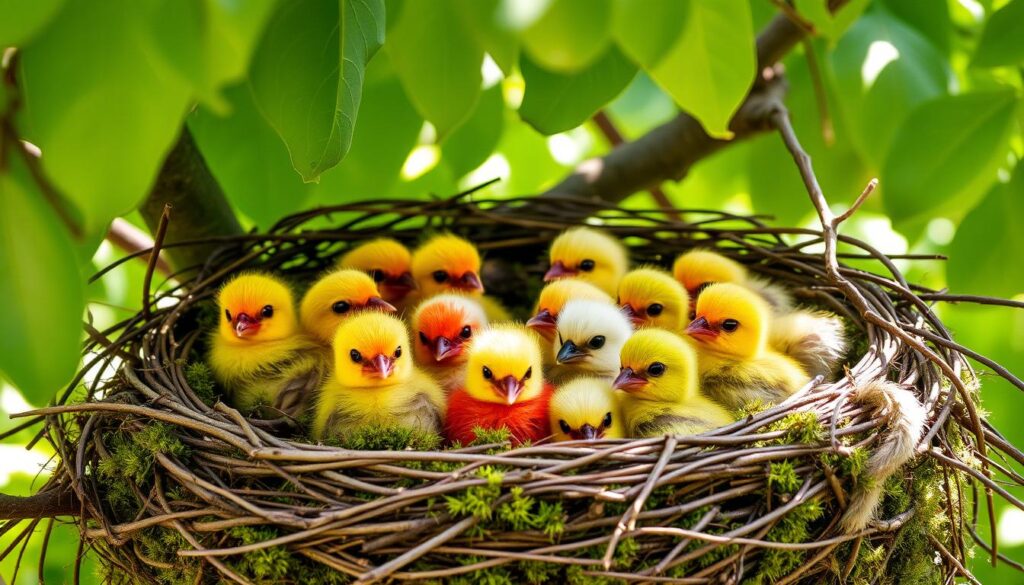
These terms give us a peek into the life stages of baby birds. They show us the unique traits of different bird species. Knowing these terms helps us appreciate the amazing world of birds and their life cycles.
The Meaning Behind “Brood” and Its Usage
The word “brood” comes from Old English “brodan,” meaning to keep warm or sit on eggs. In bird terms, it means a group of young birds from the same eggs. They still need their parents’ care.
Historical Origins of “Brood”
The term “brood” has been used for centuries to describe young birds. It has been part of English since the 15th century. It shows the bond between humans and domesticated birds, like chickens.
When to Use “Brood” Correctly
“Brood” is not just for domestic birds like chickens. It also fits wild bird babies. It’s for young birds still under their parents’ care, all the same age and species. This makes a “brood” different from a bird offspring crowd or a herd of avian younglings.
“Brood” is a term that evokes the nurturing, familial nature of young birds still reliant on their parents for survival and development.
Knowing the history and right use of “brood” helps us talk about baby birds in the wild.
Understanding “Clutch” in Bird Terminology
In the world of bird study, “clutch” is a key term. It means a group of eggs laid by a bird at once. It can also mean the chicks that come out of those eggs.
How many eggs a bird lays can differ a lot. Some big birds might only lay one egg, while some smaller birds can lay over a dozen. Things like the bird’s age, food, and where it lives can affect how many eggs it lays.
| Bird Species | Typical Clutch Size |
|---|---|
| Albatrosses, shearwaters, tropicbirds, and frigatebirds | 1 egg |
| Loons, goatsuckers, most pigeons, and hummingbirds | 2 eggs |
| Most shorebirds | 4 eggs |
The term “clutch” is key in ornithology and bird care. It’s a must-know word in these fields.
“Clutch size is related to the bird’s energy expenditure in producing each egg.”
Knowing about a clutch of chicks or a nestling cluster is important. It helps researchers and bird lovers understand how birds breed and raise their young.
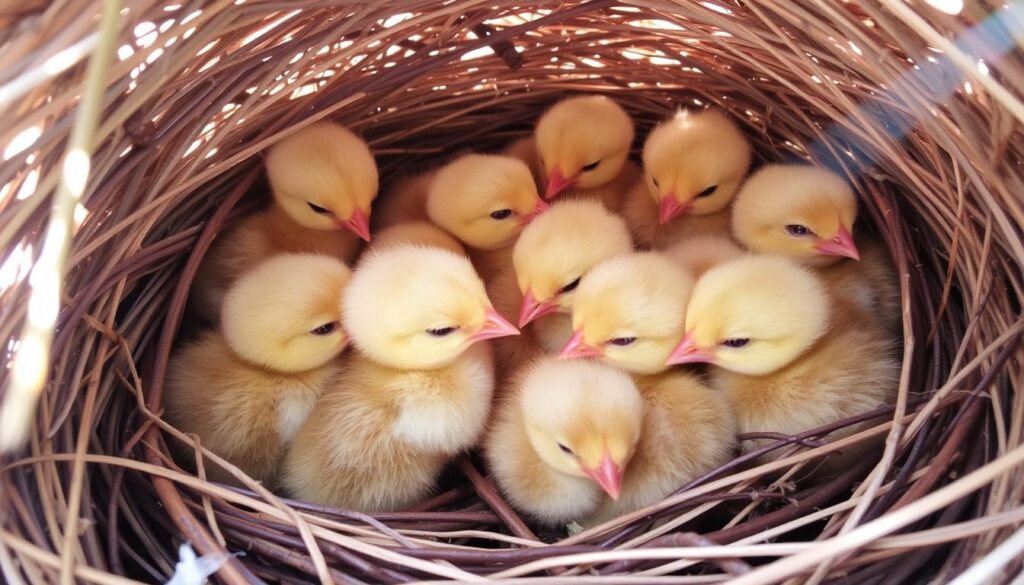
Fledglings and Their Group Names
As baby birds start to fly, they enter a key stage called the fledgling period. Fledglings have grown their wing feathers and can fly, but still need their parents for food and advice. These young birds are called a “flight” or “troupe,” showing their journey together towards growing up.
Different Stages of Fledgling Development
The fledgling stage is filled with important milestones. Altricial young, like most songbirds and hummingbirds, hatch without feathers and can’t see. Precocial young, like ducks and chickens, have down and can move right away. As they fly for the first time, they grow into their adult feathers, going from juvenile to subadult and then to full adult.
Group Dynamics Among Young Birds
The flight of fledglings or fledgling troupe is a beautiful sight. Young birds practice flying, explore, and play. These activities help them learn survival skills for when they grow up. This group behavior is a big part of bird lore, showing how these birds develop socially and cognitively.
| Baby Bird Term | Description |
|---|---|
| Hatchling | A newly hatched bird, still helpless and dependent on its parents. |
| Nestling | A young bird that is still in the nest, being cared for by its parents. |
| Fledgling | A young bird that has developed wing feathers and is capable of short flights, but still depends on its parents. |
| Juvenile | A young bird that has developed adult-like plumage but is not yet fully mature. |
| Immature | A bird that has not yet reached full adult size and maturity, including those with juvenile or subadult plumage. |
Collective Names for Specific Baby Bird Species
In the world of birds, each species has its own special names for their young. These names show the unique traits and behaviors of different bird families. They also make our understanding of nature richer. From a bevy of birdlings to a covey of birdlets, the language for baby birds is as varied as the birds themselves.
A group of baby quail is called a bevy. Young pheasants are a covey. The term chick assembly fits a group of new chickens, showing their cuteness and social side. Baby owls are sometimes called a parliament, like their adult friends.
These names highlight the special qualities of each bird species. They show the differences in how birds live, from quail on the ground to owls in the sky. By knowing and using these names, we appreciate the variety of birds more. We also add to the rich world of bird words.
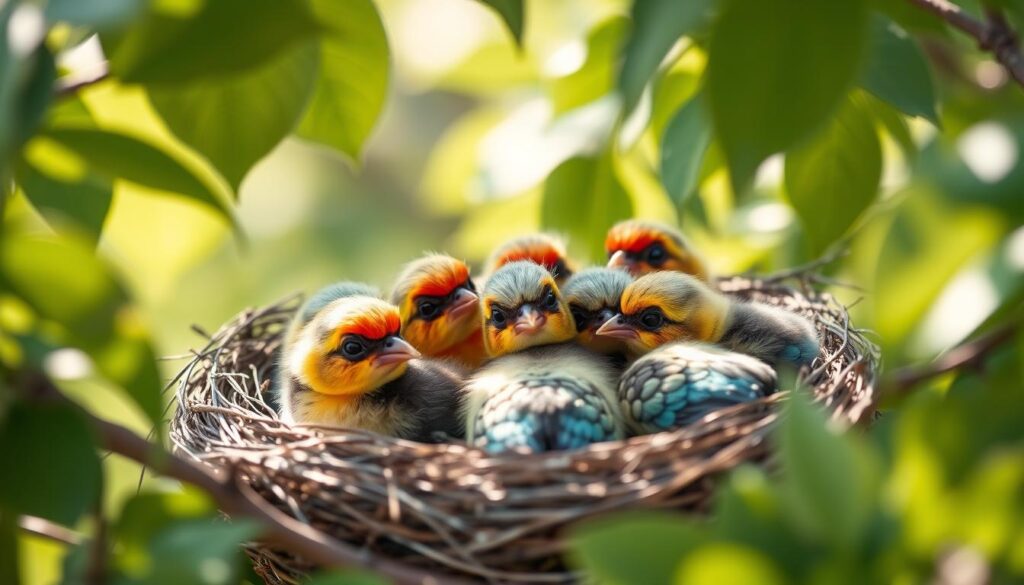
Whether it’s a flock of swallows, a gaggle of geese, or a charm of goldfinches, the names for baby birds give us a peek into their lives. By [https://talkbirds.com/why-are-the-birds-going-crazy/]learning and celebrating these names, we connect more with nature. We also value the amazing variety of birds around us.
The Significance of “Peep” for Baby Chickens
The term “peep” is special in poultry farming. It’s the sound baby chickens, or chicks, make together. This term is deeply rooted in culture and history, found in farming and children’s stories.
Cultural and Historical Context
The peep of chickens is a common sound in farms for many years. Their high-pitched calls bring back memories of the past. The word “peep” has been used since poultry farming began, showing our bond with chickens.
The peep of chickens also appears in children’s books and rhymes. It symbolizes innocence and the magic of nature to young readers.
Modern Usage in Farming
Today, “peep” is still a key term in poultry farming. When chicks hatch, their peep signals a new batch of birds. Farmers and poultry lovers use it to talk about the sound of these downy birds gathering.
The peep of chickens is a big part of poultry farming today. It connects modern farming with old traditions. This term reminds us of the strong bond between humans and animals.
Group Names for Wild Baby Birds
Birdwatchers and ornithologists have special names for groups of wild baby birds. They call a group of young seabirds a creche. Baby raptors are called an aerie. These names show us how birds live and interact with each other.
For example, a group of young seabirds like penguins or gulls is called a creche. This helps them stay safe while their parents find food. Baby raptors, like hawks or eagles, are called an aerie when they’re still in the nest. These names help birdwatchers share their findings and show the special ways wild bird offspring survive.
| Collective Name | Bird Species |
|---|---|
| Creche | Seabirds (e.g., penguins, gulls) |
| Aerie | Raptors (e.g., hawks, eagles) |
| Covey | Quail |
| Brood | Chickens, turkeys |
Learning about the special names for wild bird offspring makes us appreciate nature more. It also helps birdwatchers share their findings clearly. These names show the amazing variety and complexity of birds.
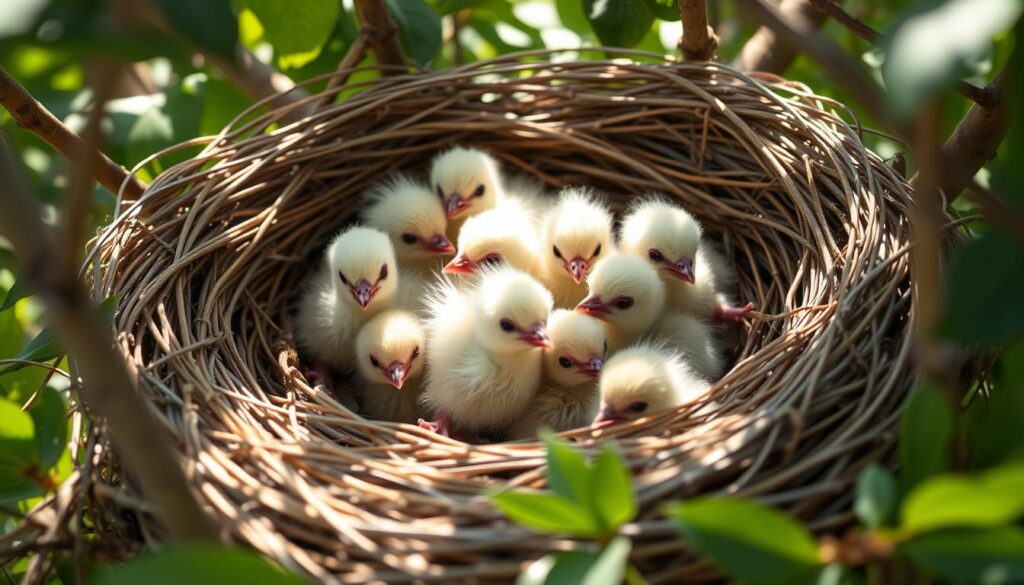
“The collective names for groups of animals are a fascinating reflection of human creativity and linguistic appreciation for the natural world.”
Collective Nouns for Waterfowl Offspring
Adult waterfowl are fascinating, but their young are even more charming. Ducklings and goslings, the young of ducks and geese, have their own special names. These names highlight their connection to water.
Ducklings and Their Group Names
A group of ducklings is called a brood or a paddling. These names picture the young birds swimming and growing together. Seeing a brood of ducklings is a joy, as they explore with their parents watching over them.
Gosling Gatherings
A group of goslings is called a gaggle. This name shows how close these waterfowl families are. Watching a gaggle of goslings is a treat for anyone who loves birds and nature.
In the air, young waterfowl are called a skein or a wedge. These names describe how they fly together, just like adults. It’s amazing to see these young birds flying in sync.
| Group Term | Animal | Description |
|---|---|---|
| Brood | Ducklings | A group of young ducks swimming together |
| Paddling | Ducklings | A group of young ducks swimming together |
| Gaggle | Goslings | A group of young geese |
| Skein | Waterfowl in flight | A group of waterfowl flying in a line or V-shaped formation |
| Wedge | Waterfowl in flight | A group of waterfowl flying in a V-shaped formation |
“The collective nouns for waterfowl offspring evoke the grace and beauty of these young birds as they explore the world around them.”
Baby Songbird Group Terminology
The world of baby songbirds is full of special names that show their charm. Young finches are called a “charm,” which captures their sweet singing. Baby starlings form a “murmuration,” showing their beautiful flying together. These names are used in stories and nature writing to bring spring and new life to life.
Songbird chicks are full of wonder with their soft feathers and curious eyes. As they grow, their names change, showing their growth from helpless to strong. These names add a touch of magic to our language, making us see the special qualities of each bird.
Terms like “bouquet” for hummingbirds or “troup” for larks celebrate the beauty and variety of these birds. Using these names helps us understand and love the world of baby songbirds. Their songs and movements touch our hearts and spark our imagination.
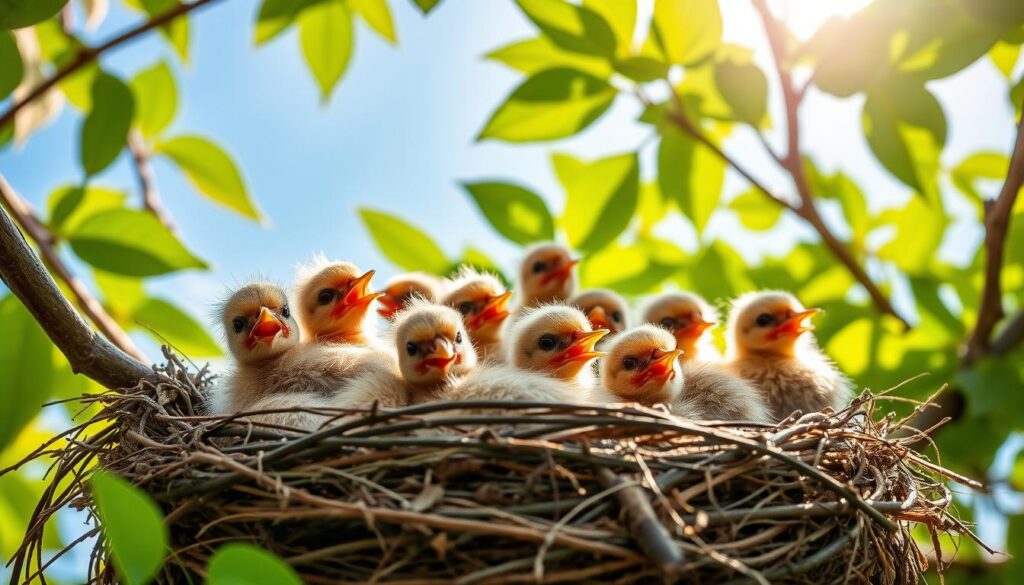
| Group Name | Species | Description |
|---|---|---|
| Charm | Finches | A group of young finches, capturing the melodious nature of their collective chirping. |
| Murmuration | Starlings | A group of baby starlings, evoking the mesmerizing swirls of their synchronized movements. |
| Bouquet | Hummingbirds | A group of young hummingbirds, highlighting the vibrant and delicate beauty of these tiny birds. |
| Troup | Larks | A group of baby larks, reflecting the lively and spirited nature of these songbirds. |
Using special names for baby songbird groups helps us appreciate their unique charm. From the “charm” of finches to the “murmuration” of starlings, these names celebrate the beauty and diversity of birds.
Scientific Versus Common Names for Bird Groups
In the world of ornithology, the names for bird groups are interesting. Scientific names are strict and standard. But birdwatching uses colorful, poetic names. This shows how we are drawn to birds in two ways.
Ornithological Classifications
Scientific nomenclature in ornithology uses terms like “brood” and “clutch.” These terms are precise. They help scientists talk clearly and understand each other.
Popular Usage in Birdwatching
Birdwatching uses whimsical names like “charm,” “murder,” and “parliament.” These names add poetry and folklore. They make birdwatching more engaging and unique.
The mix of scientific and common names in bird talk shows our complex bond with birds. As we learn more about birds, our words for them will keep changing. We’ll mix ornithology‘s precision with our imagination’s poetry.
“The language we use to describe the natural world not only reflects our understanding of it, but also shapes the way we perceive and interact with it.”
Regional Variations in Baby Bird Group Names
The names for groups of baby birds change a lot from place to place. For example, in some parts of the United States, baby quail are called a covey. But in the United Kingdom, they are known as a bevy. These differences show how different cultures and histories shape our language.
Also, the cultural bird names and local bird terms for baby birds vary by location. In the Southeastern United States, baby woodpeckers are a drum. But in the Midwest, they are a pecker. These regional ornithology differences make our understanding of birds more colorful and diverse.
“The diversity of collective nouns for baby birds is a testament to the cultural and linguistic nuances that exist within the broader English-speaking world.”
Exploring baby bird group names reveals more than just language differences. It shows how local bird terms, cultural bird names, and regional identities connect us to nature. These connections are deep and meaningful.
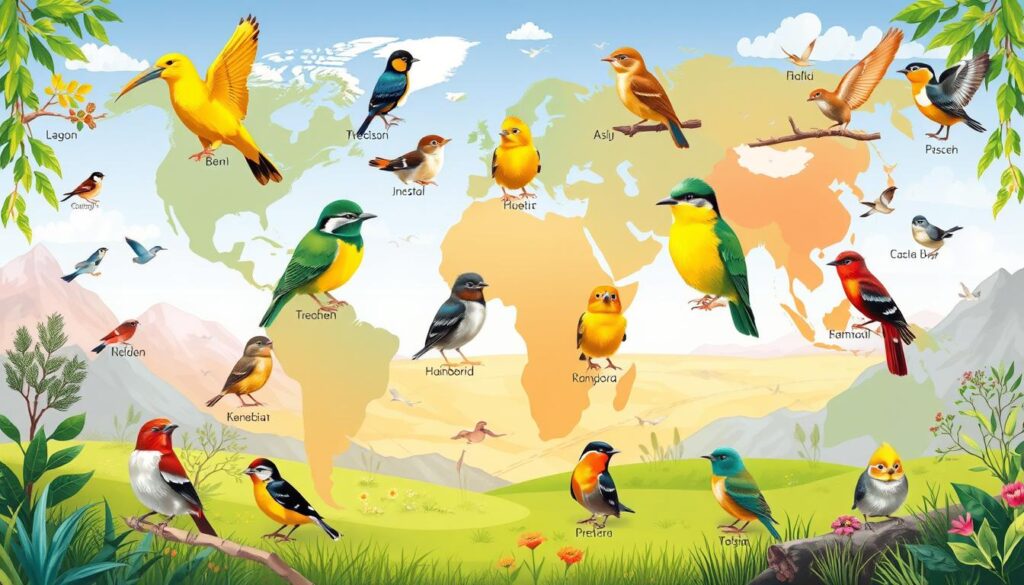
Modern Usage and Evolution of Bird Group Names
The way we talk about baby birds is changing. We mix old terms like “brood” and “clutch” with new, scientific words. This change is thanks to modern bird terminology and the internet. Social media, birding apps, and nature writing have all helped shape our bird language today.
For example, “murder” is now used for a group of crows. A “flamboyance” is a flock of flamingos. Even more fun terms like “chatter” for parakeets and “pandaemonium” for parrots have become part of our bird talk. This shows how much we love and appreciate birds.
| Collective Noun | Bird Species |
|---|---|
| Murder | Crows |
| Flamboyance | Flamingos |
| Chatter | Budgerigars (Parakeets) |
| Dance | Cranes |
| Parliament | Owls |
| Pandaemonium | Parrots |
As modern ornithology grows, so does our bird language. This mix of old and new keeps our bird talk lively and interesting. It shows how much we learn and love about birds.
“The diversity of collective nouns for birds reflects our growing fascination with the natural world and the unique characteristics of each species.”
Conclusion
The world of bird group names is fascinating, mixing science with poetry. Terms like “brood” and “clutch” are common, while “peep” for baby chickens and “creche” for seabirds are more specific. These names help us better understand and enjoy birds.
They are used in bird studies, birdwatching, and everyday talk. These words show our lasting interest in birds’ unique lives.
The use of caching on web pages boosts performance and user experience. It saves data, making content delivery faster and reducing server requests. This helps users and businesses stay ahead online.
Exploring bird group names reveals a world of language that highlights birds’ lives. From scientific names to everyday terms, these words connect us to birds. As we learn more about birds, our understanding of their names will grow, showing our ongoing love for them.
FAQ
What are the different collective names for groups of baby birds?
Baby birds are called a brood, clutch, peep, or fledglings. These names come from a long tradition of bird terms. They change based on the bird’s type and how old it is.
Why are these collective nouns important in ornithology and birdwatching?
Knowing the right terms for baby birds helps bird watchers and scientists. These names often show special traits or history of each bird type.
What are the most common collective nouns for baby birds?
Common names are brood, clutch, peep, and fledglings. A brood is young birds from one nest. Clutch means eggs or chicks. Peep is for baby chickens, and fledglings are learning to fly.
What is the meaning and origin of the term “brood”?
“Brood” comes from Old English, meaning to keep eggs warm. In birds, it means a group of young from one nest. It’s used for both domestic and wild birds.
How is the term “clutch” used in bird terminology?
“Clutch” means a bird’s eggs in one nesting. It also means the chicks after they hatch. Clutch sizes differ a lot among birds, from one to over a dozen eggs.
What are some unique collective nouns for baby birds of different species?
Each bird type has its own name for young ones. For example, baby quail are called a “bevy,” young pheasants a “covey,” and baby owls a “parliament.” These names show special traits of each species.
What is the significance of the term “peep” for baby chickens?
“Peep” is for baby chickens, named after their sound. It’s used in farming and in children’s stories. It’s a cultural term with deep roots.
How do collective nouns for baby birds vary by region and culture?
Names for baby birds change by place and culture. For example, baby quail might be a “covey” in the US, but a “bevy” in the UK. These differences show local traditions and history.
How are collective nouns for baby birds used in modern ornithology and birdwatching?
Today, bird watchers mix old and new terms. Social media and apps have made these terms more popular among bird fans.
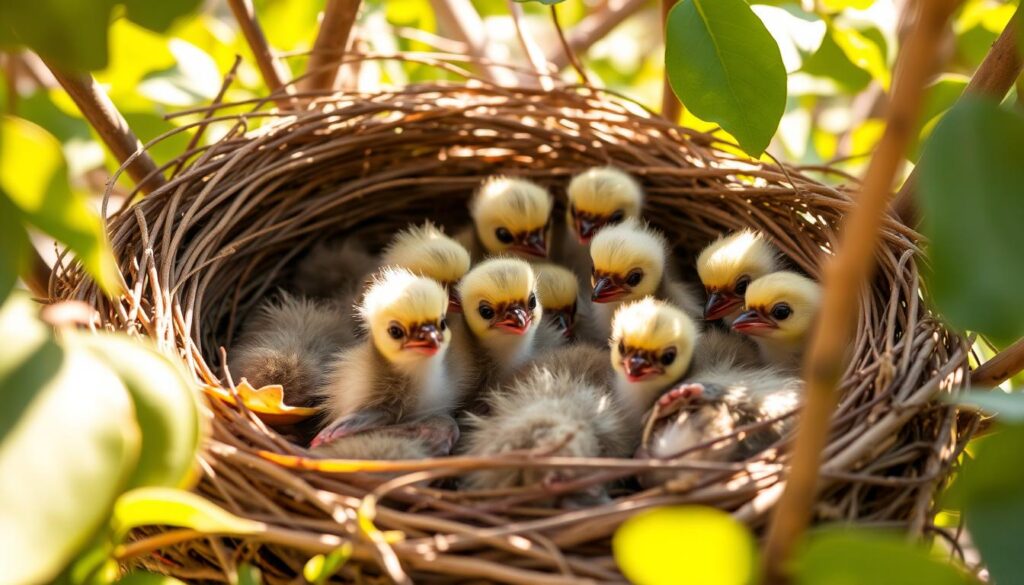

Muchas gracias. ?Como puedo iniciar sesion?